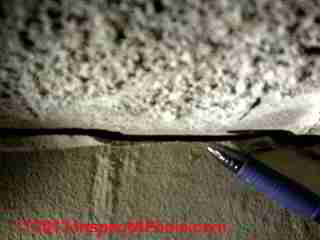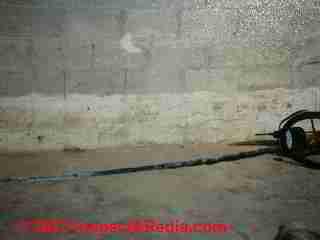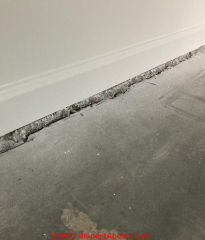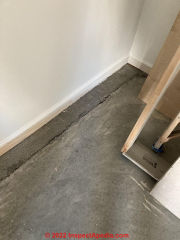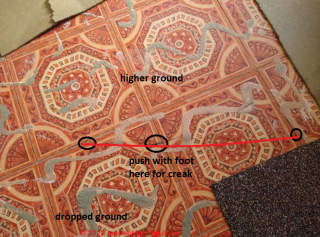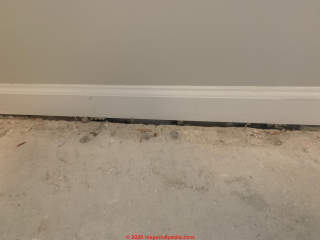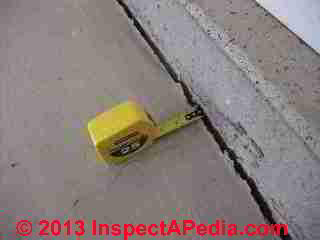 Concrete Shrinkage Gaps
Concrete Shrinkage Gaps
Identify & Evaluate Shrinkage Cracks in Concrete Floors Along Foundation Walls
- POST a QUESTION or COMMENT about how to identify & evaluate concrete shrinkage cracks between the floor slab and foundation wall
A detailed guide to concrete shrinkage cracks:
How to recognize cracks or separation between the concrete floor slab and building foundation walls: concrete floor slab shrinkage, how to evaluate normal concrete slab shrinkage, and how to recognize when cracks along a foundation wall at the floor indicate a problem.
This forms part of our longer concrete cracking article which describes the types of cracks that occur in poured concrete slabs or floors and explains the risks associated with each, thus assisting in deciding what types of repair may be needed.
This article series describes how to recognize and diagnose various types of foundation failure or damage, such as foundation cracks, masonry foundation crack patterns, and moving, leaning, bulging, or bowing building foundation walls.
Types of foundation cracks, crack patterns, differences in the meaning of cracks in different foundation materials, site conditions, building history, and other evidence of building movement and damage are described to assist in recognizing foundation defects and to help the inspector separate cosmetic or low-risk conditions from those likely to be important and potentially costly to repair.
InspectAPedia tolerates no conflicts of interest. We have no relationship with advertisers, products, or services discussed at this website.
- Daniel Friedman, Publisher/Editor/Author - See WHO ARE WE?
Shrinkage Cracks in Poured Concrete Slab Floors Along the Foundation Walls
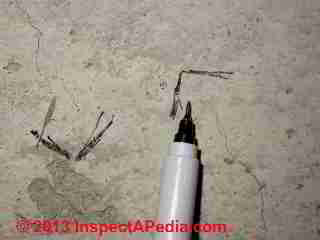
Shrinkage cracks in poured concrete are easily recognizable and can be distinguished from other types of cracks that occur later in the life of a foundation wall or floor slab.
Here we discuss two types of poured (placed) concrete shrinkage cracks: meandering fine cracks that appear in the open area of the floor or perhaps a wall (shown at left) , and straight cracks or gaps that appear at the juncture of the poured concrete floor and the foundation wall against which it abuts (shown below).
What is unique about shrinkage cracks in concrete is that when they occur in the field of a poured concrete wall or floor, they usually appear to be discontinuous, as shown at left where I marked the two ends of two shrinkage cracks with my black marker.
The shrinkage crack that occurs in the open field of a poured concrete floor or slab will meander along in the concrete, taper to a stop, and then continue beginning in a parallel line to the first crack, meandering again through the concrete.
This is characteristic of concrete (or mud) shrinking while giving up its moisture.
Shrinkage cracks are discussed separately and in excruciating detail
at SHRINKAGE CRACKS in SLABS .
...
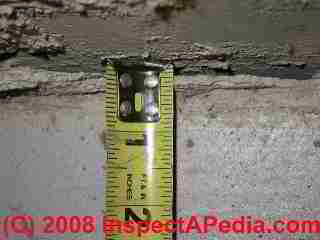 Watch out: while usually concrete shrinkage cracks are very fine in width, 1/16" or less across, severe shrinkage cracks due to mixing or temperature/curing problems can be much larger - enough to require more extensive repairs.
Watch out: while usually concrete shrinkage cracks are very fine in width, 1/16" or less across, severe shrinkage cracks due to mixing or temperature/curing problems can be much larger - enough to require more extensive repairs.
And cracks can appear in a floor or wall due to a combination of factors: shrinkage, loading, settlement, some of which may be significant or may combine forces to cause actional damage or leaks.
How to Identify Slab Shrinkage Along a Building Wall
Shrinkage cracks that occur at the juncture of slab to wall (and also within control joints) appear differently than their brothers out in the middle of the floor or wall.
Look at the photo just above and again here at left. You can see a small gap, about 3/16" wide, which runs along the entire floor slab where it meets the building foundation wall.
The gap is rather constant in width, and if you look closely you can see concrete remains on the foundation wall where the floor was touching the wall at the time it was poured.
...
A poured concrete slab shrinks away from its perimeter - the building's foundation walls. You will see this shrinkage of even a perfect concrete floor slab with no visible cracks elsewhere in the field of its surface if the floor was poured inside of an existing foundation.
Look for the gap between the edges of the slab and the foundation wall? Look also for the stains or concrete debris on the wall at the slab level? These confirm that at the time the slab was poured it was touching the wall.
The crack shown at page top is a normal condition where a poured concrete slab is installed.
Serious Floor Slab Settlement May be Indicated by Examining Floor shrinkage Cracks at the Foundation Walls
 Watch out: while shrinkage crack openings between a floor slab and its foundation (shown above) wall are normal, there is at least one case in which you can detect important floor slab settlement in this location. In the photo above the slab has pulled away from the foundation wall.
Watch out: while shrinkage crack openings between a floor slab and its foundation (shown above) wall are normal, there is at least one case in which you can detect important floor slab settlement in this location. In the photo above the slab has pulled away from the foundation wall.
But the original concrete debris left sticking to the foundation wall is at the same height as the top of the floor slab itself.
The concrete floor slab in the photo above was probably poured on top of the foundation wall footings, and the chance that the floor would have settled down in this location is slim.
The only difference in height between the original wall/slab contact point and the cured slab would be the slight shrinkage in the thickness of the slab itself.
In our concrete floor settlement photo shown at left the green arrow points to a concrete pour trace left on the building foundation wall - this is where the top of the slab was located when the floor was first placed or poured.
The red arrow in the photo above points to the present top of the same concrete floor slab - it has settled several inches!
...
A different concrete floor settlement example is in the photo at left. Here the garage floor has broken close to the foundation wall, and the slab has dropped more than 1/2". We suspect improper soil compaction under the slab.
Why would part of the garage floor remain attached to the foundation wall while other floor sections break away? Perhaps the slab was pinned to the foundation wall with re-bar.
So when will we see a settlement problem in a concrete slab at a foundation wall? Some concrete slabs are poured atop deep backfill inside of a foundation.
This is particularly common when an attached garage is built adjacent to a house on a sloped lot. When the rear of the garage (opposite the entry door) is over a hill that sloped down away from the garage entry, the builder had to place extra fill inside the garage foundation before pouring the slab.
Watch out: other more variegated concrete crack patterns may be ascribed
to FOUNDATION DAMAGE by MATERIAL or INCLUSIONS producing crack patterns in concrete caused by inclusion of iron sulfide (pyrrhotite) particles in the concrete mix.
Conditions Leading to Garage or Building Interior Floor Slab Collapse
As we can testify from our first construction job (raking fill dirt level inside of foundation walls in Dam Neck Virginia in 1963), the builder often fails to compact the fill-soil. Pouring a slab atop of soft fill can lead to serious slab settlement, settlement cracking, and in extreme cases, a dangerous collapse of the floor slab. A floor slab can collapse under these conditions:
- The floor slab or portions of it were poured on significant amounts of poorly compacted fill-soil
- The floor slab was poured on fill over the foundation wall footings, and the slab was not pinned to the foundation wall
- The floor slab is not resting on the foundation wall footings throughout all of its perimeter
- Water from roof or surface runoff has passed under the floor slab, adding to soil compaction there
- The floor slab was poured without sufficient (or any) reinforcing steel
- The weight of vehicles contributes to cracking of the slab
A case was reported to us of a car actually falling through the garage floor slab.
Common Signs Warning of a Floor Slab Collapse
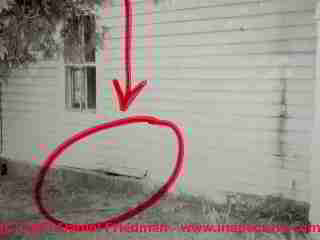
Slab push out foundation cracking: Our photo at above left shows how a concrete garage slab has pushed over the foundation wall easily seen from outside.
This damage occurred as the floor slab broke and began to collapse; tipping slab edges actually pushed out a surrounding concrete block foundation wall.
Watch out: because combinations of forces can be at work on a foundation wall that seems "cracked" or damaged in any way, it is possible to have both old movement that occurred at the time of backfill or construction (wavy mortar that is not broken) and more recent ongoing movement and damage from any of a variety of causes. Here are some clues to watch for:
- Significant downwards movement of some cracked, uneven slab sections, shown by comparing the present location of the slab upper surface with the concrete marks left along the foundation walls when the slab was originally poured.
- Significantly cracked and uneven floor slabs over an area where several feet of fill would have been placed inside the foundation walls before pouring the slab
- Horizontal cracks, bulging, or leaning visible along the outside of a concrete block foundation wall near the height of the floor slab (caused by lateral pressure of earth loading as the slab sinks downwards, pushing the soil out). (As in the two photographs shown above.)
Tip for detecting voids in fill under a concrete slab: Try dragging a heavy chain over the floor of a garage or in any location where you suspect the slab was poured over deep fill. The sound of the chain will change significantly if it passes over a void in the slab.
Do we need to repair shrinkage cracks in slabs along the Foundation Walls?
Shrinkage cracks between a floor slab and the foundation wall do not need to be repaired except in these instances:
- Water entry: Shrinkage cracks in a concrete slab or floor wherever they occur, including along a foundation wall might need to be repaired to avoid water leakage from below
the slab.
Of course you should also be taking other steps to direct water away from the building as well since sealing a floor crack is a "last-ditch" band aid effort to address water entry and it's likely to fail in the long run. - Radon entry: Shrinkage cracks in a concrete slab or floor wherever they occur, including along a foundation wall might need to be repaired to stop radon gas from entering the building.
See POLYURETHANE FOAM INJECTION CRACK REPAIRS as an effective method for sealing wide gaps or cracks in masonry walls & floors.
While shrinkage in poured concrete walls or floor slabs is a normal property of curing concrete, shrinkage cracks
can be controlled, or where they have occurred, in some cases repairs are needed.
In addition to
reading about repairing concrete shrinkage cracks (if crack repair is needed at all)
at FOUNDATION REPAIR METHODS for shrinkage cracks.
Also see how we prevent shrinkage cracks in poured concrete floors and walls by reading
CONTROL JOINT CRACKS in CONCRETE .
...
Reader Comments, Questions & Answers About The Article Above
Below you will find questions and answers previously posted on this page at its page bottom reader comment box.
Reader Q&A - also see RECOMMENDED ARTICLES & FAQs
On 2022-04-29 by Inspectapedia Com Moderator - concerns about garage concrete floor's shrinkage and settling
@ JL ,
Answer to your perfectly understandable question:
"So if I understand correctly, the problem is limited to the slab on grade garage floor further settling? "
In sum, I cannot possibly KNOW that the only concrete question is the one you've shown me, so I can't promise you that.
Take care: if you press other people the way you've pressed me it could cost you a LOT of money.
When you push someone to promise more and when they have nothing but the picofarad of information that I have about your home, the risk is that they give up and just tell you to do the most expensive thing possible.
With all due respect, I ask you to understand that I can not inspect your home based just on a brief text and some photos.
Under the aegis of wanting to be helpful I've told you some basic concepts based on the little I can see and know.
I have not seen and know nothing about the rest of the structure of your home.
If you have any reason to think that the same questionable concrete in your garage may be elsewhere, or if you simply can't make yourself comfortable with the question, then it's time to have the structure inspected, thoroughly, by an on-the-scene independent expert such as an experienced mason, concrete engineer, or home inspector.
On 2022-04-29 by JL
@Inspectapedia Com Moderator, thank you. So if I understand correctly, the problem is limited to the slab on grade garage floor further settling? The only construction pictures I have of this front view of my house show gravel, then a plastic sheet, then rebar, and then concrete was poured.
I don’t have anything showing soil compaction, but it is red Georgia soil. I do see the foundation wall where the chips/ crumbling were seen today were present from the get go.
On 2022-04-28 by Inspectapedia Com Moderator
@Anonymous,
Sure, in this regard:
Concrete placed at different times may indeed have been of different mix, poured under different conditions, even possibly by different contractors, thus of different quality and with different results.
The condition of the garage slab may be entirely different from the surrounding, independent foundation as well as from the foundation and basement floor of the home itself.
The garage slab on grade - if it's the only concrete in questionable shape - is not a structural collapse risk as might be a bad foundation wall or footing or monolithic slab construction or a slab poured over soils in an area of sinkholes.
On 2022-04-28 by JL
@Inspectapedia Com Moderator, Does it make a difference in your assessment if I told you the garage floor concrete was poured separately from the foundation wall? (I have a basement home with an attached garage in the front of the house that doesn’t sit over any living space.) Thank you again.
On 2022-04-28 by Inspectapedia Com Moderator
@Anonymous,
From my remote seat I don't know enough about just what's going on. That's why I suggested an onsite expert who's independent from the installing contractor.
Slab-jacking can work but we don't know the extent of trouble and don't know that the pour isn't so bad that it needs to be removed and replaced - so I'd hate to spend on slab jacking only to later have to do the whole job over.
In guessing at the extent of under-slab voids I would inspect the exterior to see where runoff is going and I'd look over any photos of the home during construction to see what sitework and excavation and fill and compacting went-on (or didn't).
I used to drag an old chain (no kidding) across the garage floor. You can hear changes in the pitch of the noise when the chain passes over a void.
As your slab is pretty new - more settlement may occur.
You can often reduce slab settlement by keeping roof and surface runoff away from the foundation.
On 2022-04-28 by JL
@Inspectapedia Com Moderator, Thank you for your incredibly helpful & fast response. What would be a potential appropriate fix? Do you see slabjacking and the like in the future?
I have been told these are cold joints (foundation wall and garage floor poured separately) and separation is normal. And that the floor didn’t sink, it was designed to slope down towards the garage door.
Still doesn’t explain the crumbling, because other places in the garage have a more normal clean looking separation at the joint. Thank you again.
On 2022-04-28 by Inspectapedia Com Moderator
@JL,
I'm sorry to say it looks like that wasn't a very good pour of your slab.
I think in your photos I see that there is not only shrinkage but crumbling of the concrete which suggests a problem with v mix or improper mix of concrete sand gravel and water.
It also looks as if the slab is settling that is moving downwards. You can see that often by noticing where the slab originally contacted the foundation wall and noticed that the top of the slab is now lower than the concrete fragments that remain on the wall where it broke away. If that's indeed the case then it looks as if the slab was poured on top of poorly compacted fill and additional settlement could certainly occur.
It would be appropriate to bring an experienced masonry contractor or engineer to look at the job to decide if you need to do something further.
On 2022-04-28 by JL
@Inspectapedia Com Moderator, Thanks immensely for your prompt reply. Here are better pics. In the other pics uploaded, concrete (both slab and wall) is crumbling, creating a significant gap up to 3/4".
Are these still normal shrinkage gaps in a 8 month old garage slab?
On 2022-04-27 by Inspectapedia Com Moderator
@JL,
I think so, yes. It looks as if the slab was poured up against the foundation rather than over the top edge of it. So you are seeing the joint open up from shrinkage of the slab.
On 2022-04-27 by JL
Is this gap between the garage floor and foundation wall from normal shrinkage?
On 2022-02-24 by Inspectapedia Com Moderator - concrete doesn't creak
@James,
We need some further explanation from you and perhaps a photo of the "concrete" about which you ask.
With just your existing photo it's like holding a hand over our eyes and asking us to say what we see is going on with your floor. Speculating is so likely to be wrong as to not be useful.
But here are some basic points:
Concrete doesn't "creak" when you step on it, though there could be layers of subflooring, wood, plywood, or other materials below that sheet flooring in your photo and that move when stepped-on.
If there is a concrete slab below your floor and if it is actually on the ground (as a first floor might be) there could be settlement or other causes of slab movement - but shrinkage cracks - the subject of this page - would not be at all likely to explain creaking nor movement in the slab .
Are you sure there is actually concrete movement and not movement of some layer(s) of flooring installed atop the concrete?
Is there a basement or crawl space or is your concrete slab set on grade - on the earth?
Are there other signs of building movement: cracks, bulges, bowed walls?
What are the country and city of location? Freezing climate?
On 2022-02-24 by James
Hello,
I live in a first floor 1960's flat. I have pulled up the carpet to investigate a creaking noise and found the concrete sub floor is cracked. It's as if part of the floor has broken away from the main floor and has dropped very slightly. Please see attached images of cracks and direction, and where if you push with your foot it creaks. The concrete moves very slightly as you push down and makes the creaking noise. Any advice much appreciated. Thank you for reading.
On 2021-11-23 by Inspectapedia Com Moderator - concrete patching compound can repair floor
@Angela,
gently probe that light-blue-gray material: I think that is probably solid foam insulation put around the perimeter of the slab to avoid heat loss. If so, the concrete was thin over that area and so easily broken by trying to nail down tack strips. And if that's the case, simply use a concrete patching compound to repair the floor slab before installing new flooring .
On 2021-11-23 by Angela
Pulled up carpet to find this.. house was built in the 70s in Ohio, normal soil. It runs the length of two jointing exterior walls. ( whoever installed carpet blasted 3 tack strips into this are) I have more pictures… but just wondering if this is serious? Or can I repair?
On 2021-10-14 by inspectapedia.com.moderator
@John,
It'd help to see a photo (use the "Add Image" button) -
and to know details about the crack: its width, pattern, length, and whether there is any vertical dislocation: that is, is the floor at the same height on both sides of the crack.
In the other articles in this series, starting at CONCRETE SLAB CRACK EVALUATION you'll see how we distinguish between harmless - cosmetic - concrete shrinkage cracks and others.
On 2021-10-14 by John
I have a crack in the garage floor extending from a support pillar diagonally across the floor to the garage wall. On one side of the crack at the wall there is no crack and the other side there is a crack and space between the wall and floor slab
On 2021-04-23 by (mod) - how to seal Shrinkage gaps around the perimeter of a slab
@Hannah,
Shrinkage gaps around the perimeter of a slab are common and normal as you'll read above on this page.
Don't seal with concrete; see
SEAL CONCRETE CRACKS, HOW TO a description of various products and methods used to seal or repair cracks in poured concrete walls, foundations, floors, & slabs.
There we describe a number of sealants (caulk-like material, injected foam, other)
By "flexible" I mean just that; if you were to use epoxy or mortar, for example, to seal a concrete crack or gap, and if there is much thermal or mechanical movement later-on, your non-flexible material will simply crack anew.
On 2021-04-23 by Hannah
by flexible sealant do you mean a rubberized product like flex seal? Or eagle's solvent based acrylic concrete sealer?
I'm sorry if this is a dumb question, but when you say "flexible sealant" do you mean something like flexbond? Can I pour half a gallon of flexbond into a concrete crack?
One more, here my fingers are spanning the gap, resting on what I think is the stemwall
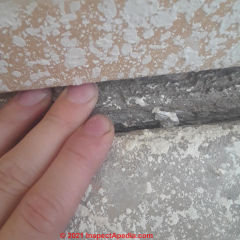
My home was built in 1973, and I just pulled out the original carpet! The carpet tack slats had been nailed into the concrete, which crumbled around the nails when I pulled them out.
However, when I pulled up the baseboard, there appears to be a decent gap between the slab and the foundation wall. They are on the same level, it almost seems like it was poured that way.
It's a kind of v shape, sloped sides, and over an inch deep.
How do I seal this up? Would you recommend pouring concrete into It? Or polymer caulk? I'm a newbie, any product recommendations would be hugely appreciated!
On 2021-04-06 by (mod) - concrete floor slab cracks in Arizona
@Kim,
A flexible sealant will work better at a gap between the floor slab and foundation wall as well as in other concrete cracks and gaps such as those you describe.
Is my water damage do you mean water is entering the building that's a separate problem that needs to be addressed by getting the water away outside.
Also from your question I'm not sure that you don't have a problem with expensive soil that needs to be addressed. Did your engineer, done that?.
On 2021-04-06 by Kim
Our stem wall is intact. We pulled carpet up and noticed cement leveler. The corner settled at some point. Had a engineer look at it and they said the stem wall looked good. Whoever poured the slab did a poor job. Trying to decide between Epoxy resin, polyurethane filler or hydraulic cement to fill in the crack between the cement slab and stem wall.
I live in Northern Arizona so this is most likely a temperature related expansion and retraction of the clay soil. There isn’t a spot where there is water damage. Any advice would be great!
On 2021-02-17 - by (mod) -
MissI can't see enough context to understand what's going on - please take a look at the illustrations of typical concrete slab shrinkage gaps on the page above and let me know if that's what you've got.
On 2021-02-17 by miss alia
is this structural defect( gap between wall and garage floor near entrance of home, near anchor, what needs to be done to fill the gap and how much will be the estimate. please email me replies at following email address
dazzlingface@gmail.com

On 2020-06-04 - by (mod) - evaluate further broken-up concrete around perimeter of a 1950s floor slab
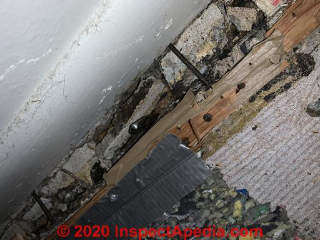 Jenna
Jenna
Thank you for the helpful question and photo of damage around the edge of your floor slab.
No it is not normal for the slab to be broken into pieces around the perimeter of your floor.
However it's not something that you should be too panicked about is that in turn may be worse for you than the floor itself, both health-wise and cost-wise.
To make sense out of the condition of the floor or more thorough diagnosis is an order.
I suspect from the little bit that I can see in your photo that in addition to normal concrete slab shrinkage your floor slab may have settled.
On a house as old as the one you described if that condition is not ongoing I would probably simply remove the loose concrete, repair and seal the Gap, and be sure outside that I'm keeping water away from the foundation.
Only if we find that there is ongoing movement or serious slab breakage or heating might more extensive repair be needed.
On 2020-06-04 - by Jenna
Pulling up our carpet last night, we found a significant gap between the concrete slab and wall.The house was built in the 50s and the majority of the concrete slab is deteriorating around the inside of the home next to the wall but this area was the worst that we have found so far. It’s in pieces and you can pull the concrete right out. Is this normal?
On 2019-11-30 - by (mod) - fill & seal stable concrete shrinkage gaps
I'd want to be more confident that I understood exactly what is going on: slab settlement, slab shrinkage, foundation movement (of which cracks can be an early indicator), before choosing a repair,
but that said, in general it may be pretty easy to vacuum out the bugs and carpet dust and the fill the existing cracks around your slab with a flexible sealant such as those used in radon remediation.
On 2019-11-30 by Tempest Haze
Hello. This ranch home is in Charlotte NC and was built in 1997.
No major repairs have been done regarding settlement issues and there are no known issues beyond my recent discovery upon lifting up the carpet.
There are small vertical cracks in the brick veneer however a structural engineer has already ruled it as unsubstantial. There are consistent gaps between the slab and foundation in multiple rooms.
I would like to repair the gaps based on what I’ve read on your site to avoid radon gas and water entry however I am concerned that the repairs may be expensive.
Is this a DIY repair? Other cracks are throughout the home that mostly begin at the edge of the slab and run along the entire room from end to end.
On 2019-10-26 by (mod) - evaluate shrinkage gap in new home floor slab
 Jeff
Jeff
While an onsite expert would certainly have much more information and could reach more-reliable conclusions, from your photo this looks to me like common concrete shrinkage gaps around the perimeter of a slab that appears to have been poured inside of a footing or foundation wall.
If the slab is not settling - that is it has not dropped - then it's not raising a red flag.
Depending on the age of the floor slab and building foundation - and this is all brand new work - there could still be a future settlement problem IF the soil under the slab was not properly compacted.
Keep surface drainage and roof runoff away from the foundation.
You may also want to use a flexible sealant to close the gap against moisture or radon from below.
(See CONCRETE SEALANTS in the ARTICLE INDEX )
On 2019-10-26 by Jeff
Evaluating a new construction home with a shrinkage gap between the slab and the foundation footers. Picture shows the floor separated from the footer. Is this an issue that needs repair?
Any help is appreciated. This slab is on a sloped lot and this is the downhill side.
On 2019-09-07 by (mod) - large crack around floor slab
 Shelly
Shelly
What are we looking at here? A gap between floor and wall?
IF so the gap looks unusually large, and there appears to be some floor settlement: so both further investigation and at the very least, sealing are in order.
To have an opinion I'd need to know a bit more than what one can see ( a significant crack that looks like concrete, with - oddly- what looks like a piece of drywall sitting on and covering most of the floor)
Is this a slab on grade single family home located on NORMAL SOIL at a NORMAL SITE i.e an area without sinkholes and subsidences?
What are the country and city of location ?
What is the age of the home?
What is the terrain shape: flat, hillside, mountain, etc. ?
What other evidence of movement, settlement, or prior repairs are there at the home?
Has the home been subjected to unusual stresses: earthquake, flooding?
Without meaning to sound glib, very few homes are "beyond repair" because of damage or a crack or even movement; but that isn't enough information.
This could be a floor shrinkage gap (not normally much of a concern) or it could be something else.
We need to know
- the extent of damage to the structure caused by such cracking or settlement (if any)
- the crack's cause
before one can have an opinion about the type of repair needed and its possible cost as a percent of the likely value of the home.
On 2019-09-07 by Shelley
We found this wrong the out wall in the living room oh a house we want to buy. Is it beyond repair?
On 2018-06-13 by (mod) - .5cm gap between the edge of your floor and the wall
We can't say, Judith, if the roughly 1.5cm gap between the edge of your floor and the wall is a sign of major structural problems or settlement from poor site preparation - at least not from just your photo.
But indeed a 1.5 centimeter crack is significant in size in most situations, so further investigation is warranted.
If there is no structural movement this may be simply a shrinkage gap such as is discussed on the page above.
You would look for other signs of more-serious problems such as
- cracks or movement in the building foundation
- leaning, buckling walls
- slab tilted or settled
- water entry
etc. as discussed in the article above.
On 2018-06-13 by Judith should we be worried?
We have a significant gap that has appeared between the floor and the skirting board, should we be worried?
IMAGE LOST by older version of Clark Van Oyen’s useful Comments code - now fixed. Please re-post the image if you can. Sorry. Mod.
On 2017-10-20 by (mod) -
Use a flexible sealant in the gap between slab and garage wall.
On 2017-10-20 by Nancy
How to repair slab shrinking cement in garage that is not structural
On 2016-10-10 by (mod) -
Pat I'm reluctant to bet your money on structural analysis of a home from a one-line e-text, as in every case in which an inspector goes to a property she or he finds important data that was not obvious to a normal homeowner.
But IF you are describing a concrete slab shrinkage crack that looks like and has the causes of the one shown at page top, that's not a structural issue and wouldn't merit hiring a structural engineer.
If you see walls out of plumb, heaving, bulging, bowing, signs of structural movement, you need a professional.
On 2016-10-09 by pat
I have a tri level the wall around the main floor in cracked around the foundation wear the main floor meets the block wall. There's no cracks in the walls or any were else. Should we have it looked at by a professional.
On 2016-05-14 by (mod) -
FOUNDATION REPAIR METHODS - home
On 2016-05-14 by Anonymous
Foundation settlement crack repair
...
Continue reading at CONCRETE SLAB CRACK REPAIR or select a topic from the closely-related articles below, or see the complete ARTICLE INDEX .
Or see these
Recommended Articles
- CONCRETE COLD POUR JOINTS
- CONCRETE DECK PIER PROCEDURE
- CONCRETE DIY SMALL JOB PROCEDURE
- CONCRETE DELIVERY & MIXING
- CONCRETE FOUNDATION, WALL, SLAB DEFECTS
- CONCRETE REINFORCEMENT, FIBER
- CONCRETE SHRINKAGE CRACKS
- CONCRETE SHRINKAGE CRACK REPAIR
- CONCRETE STAINS: ID & REMOVAL
- CONCRETE SLAB CRACK EVALUATION
- CONTROL JOINT CRACKS in CONCRETE
- FREEZING & WATER DAMAGED SLABS
- FROST HEAVE / EXPANSIVE SOIL CRACKS in SLABS
- SETTLEMENT CRACKS in SLABS
- SETTLEMENT vs. FROST HEAVE CRACKS
- SETTLEMENT vs. SHRINKAGE CRACKS
- SHRINKAGE CRACKS in SLABS
- SHRINKAGE CRACKS at FOUNDATION WALLS
- TEMPERATURE EFFECT on CONCRETE POUR
- CONCRETE SLAB CRACK REPAIR
- FOUNDATION DAMAGE by MATERIAL or INCLUSIONS crack patterns in concrete caused by inclusions iron sulfide (pyrrhotite) in the concrete mix.
Suggested citation for this web page
SHRINKAGE CRACKS or GAPS at FOUNDATION WALLS at InspectApedia.com - online encyclopedia of building & environmental inspection, testing, diagnosis, repair, & problem prevention advice.
Or see this
INDEX to RELATED ARTICLES: ARTICLE INDEX to BUILDING STRUCTURES
Or use the SEARCH BOX found below to Ask a Question or Search InspectApedia
Ask a Question or Search InspectApedia
Try the search box just below, or if you prefer, post a question or comment in the Comments box below and we will respond promptly.
Search the InspectApedia website
Note: appearance of your Comment below may be delayed: if your comment contains an image, photograph, web link, or text that looks to the software as if it might be a web link, your posting will appear after it has been approved by a moderator. Apologies for the delay.
Only one image can be added per comment but you can post as many comments, and therefore images, as you like.
You will not receive a notification when a response to your question has been posted.
Please bookmark this page to make it easy for you to check back for our response.
IF above you see "Comment Form is loading comments..." then COMMENT BOX - countable.ca / bawkbox.com IS NOT WORKING.
In any case you are welcome to send an email directly to us at InspectApedia.com at editor@inspectApedia.com
We'll reply to you directly. Please help us help you by noting, in your email, the URL of the InspectApedia page where you wanted to comment.
Citations & References
In addition to any citations in the article above, a full list is available on request.
- "Concrete Slab Finishes and the Use of the F-number System", Matthew Stuart, P.E., S.E., F.ASCE, online course at www.pdhonline.org/courses/s130/s130.htm
- "Best Practices for Concrete Sidewalk Construction," Balvant rajani, Canadian National Research Council
- "Design Considerations for Perlite Roof Slabs," a chapter in "Perlite Concrete Grade for Lightweight Concrete Construction", United Perlite Corporation
- Quality Standards for the Professional Remodeling Industry, National Association of Home Builders Remodelers Council, NAHB Research Foundation, 1987.
- Quality Standards for the Professional Remodeler, N.U. Ahmed, # Home Builder Pr (February 1991), ISBN-10: 0867183594, ISBN-13: 978-0867183597
- "Best Practices for Concrete Sidewalk Construction," Balvant rajani, Canadian National Research Council
- Lone Star Epoxies , Rowlett TX, product literature, includes application instructions for this flexible epoxy resin concrete expansion joint sealer. Email: ls@lsepoxies.com Web: lsepoxies.com/ConcreteJointSealant.html - 10/06/08
- Ramset Epoxy Grout Web: ramset.com.au/fileupload/resources/construction chemicals/epoxy grout tds.pdf Australia,
- Laticrete Epoxy grouts laticrete.com
- Avongard FOUNDATION CRACK PROGRESS CHART [PDF] - structural crack monitoring
- BASEMENT MOISTURE CONTROL [PDF] U.S. Department of Energy
- Building Failures, Diagnosis & Avoidance, 2d Ed., W.H. Ransom, E.& F. Spon, New York, 1987 ISBN 0-419-14270-3
- Building Pathology, Deterioration, Diagnostics, and Intervention, Samuel Y. Harris, P.E., AIA, Esq., ISBN 0-471-33172-4, John Wiley & Sons, 2001 [General building science-DF] ISBN-10: 0471331724 ISBN-13: 978-0471331728
- Building Pathology: Principles and Practice, David Watt, Wiley-Blackwell; 2 edition (March 7, 2008) ISBN-10: 1405161035 ISBN-13: 978-1405161039
- Domestic Building Surveys, Andrew R. Williams, Kindle book, Amazon.com
- Defects and Deterioration in Buildings: A Practical Guide to the Science and Technology of Material Failure, Barry Richardson, Spon Press; 2d Ed (2001), ISBN-10: 041925210X, ISBN-13: 978-0419252108.>
- Guide to Domestic Building Surveys, Jack Bower, Butterworth Architecture, London, 1988, ISBN 0-408-50000 X
- "Avoiding Foundation Failures," Robert Marshall, Journal of Light Construction, July, 1996 (Highly recommend this article-DF)
- "A Foundation for Unstable Soils," Harris Hyman, P.E., Journal of Light Construction, May 1995
- "Backfilling Basics," Buck Bartley, Journal of Light Construction, October 1994
- Masonry structures: The Masonry House, Home Inspection of a Masonry Building & Systems, Stephen Showalter (director, actor), DVD, Quoting:
Movie Guide Experienced home inspectors and new home inspectors alike are sure to learn invaluable tips in this release designed to take viewers step-by-step through the home inspection process. In addition to being the former president of the National Association of Home Inspectors (NAHI), a longstanding member of the NAHI, the American Society of Home Inspectors (ASHI), and the Environmental Standard Organization (IESO), host Stephen Showalter has performed over 8000 building inspections - including environmental assessments. Now, the founder of a national home inspection school and inspection training curriculum shares his extensive experience in the inspection industry with everyday viewers looking to learn more about the process of evaluating homes. Topics covered in this release include: evaluation of masonry walls; detection of spalling from rebar failure; inspection of air conditioning systems; grounds and landscaping; electric systems and panel; plumbing supply and distribution; plumbing fixtures; electric furnaces; appliances; evaluation of electric water heaters; and safety techniques. Jason Buchanan --Jason Buchanan, All Movie Review - Masonry structures: The Masonry House, Home Inspection of a Masonry Building & Systems, Stephen Showalter (director, actor), DVD, Quoting:
Movie Guide Experienced home inspectors and new home inspectors alike are sure to learn invaluable tips in this release designed to take viewers step-by-step through the home inspection process. In addition to being the former president of the National Association of Home Inspectors (NAHI), a longstanding member of the NAHI, the American Society of Home Inspectors (ASHI), and the Environmental Standard Organization (IESO), host Stephen Showalter has performed over 8000 building inspections - including environmental assessments. Now, the founder of a national home inspection school and inspection training curriculum shares his extensive experience in the inspection industry with everyday viewers looking to learn more about the process of evaluating homes. Topics covered in this release include: evaluation of masonry walls; detection of spalling from rebar failure; inspection of air conditioning systems; grounds and landscaping; electric systems and panel; plumbing supply and distribution; plumbing fixtures; electric furnaces; appliances; evaluation of electric water heaters; and safety techniques. Jason Buchanan --Jason Buchanan, All Movie Review - Masonry Design for Engineers and Architects, M. Hatzinikolas, Y. Korany, Canadian Masonry (2005), ISBN-10: 0978006100, ISBN-13: 978-0978006105
- Masonry Structures: Behavior and Design, Robert G. Drysdale, Ahmid A. Hamid, Lawrie R. Baker, The Masonry Society; 2nd edition (1999), ISBN-10: 1929081014, ISBN-13: 978-1929081011
- Masonry, Engineered: Using the Canadian Code, J. I. Gainville, Cantext publications (1983), ASIN: B0007C37PG
- Masonry, Non-reinforced masonry design tables, Hans J. Schultz, National Concrete Producers Association and the Canadian Masonry Contractors Association (1976), ASIN: B0007C2LQM
- Slab on Grade Foundation Moisture and Air Leakage , U.S. Department of Energy
- "Frost Heaving Forces in Leda Clay", Penner, E., Division of Building Research, National Research Council of Canada, Canadian Geotechnical Journal, NRC Research Press , 1970-2, Vol 7, No 1, PP 8-16, National Research Council of Canada, Accession number 1970-023601, Quoting from original source
The frost heaving forces developed under a 1 ft. (30.5 cm) diameter steel plate were measured in the field throughout one winter. The steel plate was fixed at the ground surface with a rock-anchored reaction frame. heave gauges and thermocouples were installed at various depths to determine the position and temperature of the active heaving zone. The general trend was for the surface force to increase as the winter progressed. when the frost line approached the maximum depth the force was in excess of 30,000 lb (13,608 KG). Estimates of the heaving pressure at the frost line ranged from 7 to 12 psi (0.49 to 0.84 KG/cm) square during this period. The variation of surface heaving force was closely associated with weather conditions. Warming trends resulting in a temperature increase of the frozen layer caused the forces to decline.
- "Geoscape Ottowa-Gatineau Landslides ", Canada Department of Natural Resources, original source http://geoscape.nrcan.gc.ca/ottawa/landslides_e.php - quoting from that source:
Leda clay slopes in the Ottawa valley are vulnerable to catastrophic landslides. More than 250 landslides, historical and ancient, large and small, have been identified within 60 km of Ottawa. Some of these landslides caused deaths, injuries, and property damage, and their impact extended far beyond the site of the original failure. In spectacular flowslides, the sediment underlying large areas of flat land adjacent to unstable slopes liquefies. The debris may flow up to several kilometres, damming rivers and causing flooding, siltation, and water-quality problems or damaging infrastructure. Geologists and geotechnical engineers can identify potential landslide areas, and appropriate land-use zoning and protective engineering works can reduce the risk to property and people.
Deposits of Leda clay, a potentially unstable material, underlie extensive areas of the Ottawa-Gatineau region. Leda clay is composed of clay- and silt-sized particles of bedrock that were finely ground by glaciers and washed into the Champlain Sea. As the particles settled through the salty water, they were attracted to one another and formed loose clusters that fell to the seafloor. The resulting sediment had a loose but strong framework that was capable of retaining a large amount of water. Following the retreat of the sea, the salts that originally contributed to the bonding of the particles were slowly removed (leached) by fresh water filtering through the ground. If sufficiently disturbed, the leached Leda clay, a weak but water-rich sediment, may liquefy and become a 'quick clay'. Trigger disturbances include river erosion, increases in pore-water pressure (especially during periods of high rainfall or rapid snowmelt), earthquakes, and human activities such as excavation and construction.
After an initial failure removes the stiffer, weathered crust, the sensitive clay liquefies and collapses, flowing away from the scar. Failures continue in a domino-like fashion, rapidly eating back into the flat land lying behind the failed slope. The flowing mud may raft intact pieces of the stiffer surface material for great distances.
- In addition to citations & references found in this article, see the research citations given at the end of the related articles found at our suggested
CONTINUE READING or RECOMMENDED ARTICLES.
- Carson, Dunlop & Associates Ltd., 120 Carlton Street Suite 407, Toronto ON M5A 4K2. Tel: (416) 964-9415 1-800-268-7070 Email: info@carsondunlop.com. Alan Carson is a past president of ASHI, the American Society of Home Inspectors.
Thanks to Alan Carson and Bob Dunlop, for permission for InspectAPedia to use text excerpts from The HOME REFERENCE BOOK - the Encyclopedia of Homes and to use illustrations from The ILLUSTRATED HOME .
Carson Dunlop Associates provides extensive home inspection education and report writing material. In gratitude we provide links to tsome Carson Dunlop Associates products and services.


